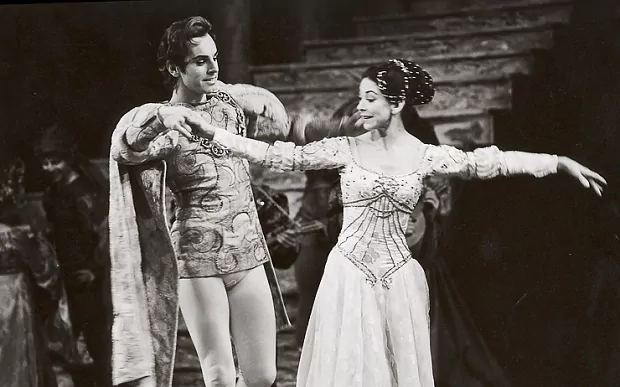Name Derek Rencher | ||
 | ||
Month in the country - Pas de Deux - Natalia Petrovna / Rakitin
Derek Rencher (6 June 1932 – 20 December 2014) was a British ballet dancer. A commanding figure among Royal Ballet character dancers for more than four decades, he was probably the most prolific performer in the company's history.
Contents
- Month in the country Pas de Deux Natalia Petrovna Rakitin
- Early life and training
- Professional career
- Roles created
- Personal life
- References

Early life and training

Rencher was born in Birmingham, an industrial, commercial, academic, and cultural center in the West Midlands of England. He grew up in a working-class family, as his father was employed by the toolmakers John Rabone & Sons. An industrious student, he won a scholarship to the Royal College of Art in London, where he pursued a course of study in design and art history. In the early 1950s, at age nineteen, he took a job as an extra during filming of Invitation to the Dance, a Gene Kelly movie intended to educate mainstream audiences about the world of professional dancing. Besides Kelly himself, and such musical theater dancers as Carol Haney and Tommy Rall, the cast included international ballet stars Igor Yousekevitch, Claire Sombert, Tamara Toumanova, Diana Adams, David Paltenghi, and Claude Bessy. Enchanted by the experience, Rencher decided to switch to a dance career and began to take ballet classes with Igor Schwezoff at his private studio and with Jill Gregory and George Goncharov, who taught alongside Vera Volkova at the Sadler's Wells Ballet School.
Professional career
Within two years, Rencher had been recruited by Ninette de Valois into the Sadler's Wells Ballet, mainly because of his impressive height, trim physique, noble bearing, and remarkably good looks. A quick learner, he made his mark in mid-1950s ballets by rising yourng choeographers Kenneth MacMillan, Alfred Rodrigues, and John Cranko. Over the next forty years, during which the Sadler's Wells Ballet was renamed the Royal Ballet, he would originate roles in ballets by Frederick Ashton, Robert Helpmann, Antony Tudor, and Rudolf Nureyev, as well as appearing in character roles in the company repertory.
Tall and lithe, with a Roman profile, Rencher cut an imposing figure on stage. He made a strong impression in his early appearances at Covent Garden in 1956, dancing in MacMillan's Noctambules and Rodgrigues's The Miraculous Mandarin. He was promoted to soloist in 1957 and to principal dancer in 1969. Almost thirty years later, as a "guest principal character artist," he danced his last season with the company in 1997-98. In his long career with the Royal Ballet, he won acclaim particularly for his powerful stage presence and for his versatility as a mime, as he was able to convey villainy, authority, and comedy with equal effectiveness. He often played a neglected or unlikeable "other man" in romantic triangles alongside the great actress-ballerinas Svetlana Beriosova, Natalia Makarova, and Lynn Seymour, to whom he provided strong but courteous emotional opposition. In 1965, when he danced Paris in Romeo and Juliet, with Margot Fonteyn and Rudolf Nureyev, he was so strikingly seductive that one viewer was moved to remark that Juliet had shown singularly poor judgment in her choice of Romeo.
Rencher was highly valued by audiences for his portrayals of antagonistic characters in classic ballets, as he was able to invest them with unexpected dimensions. His Von Rothbart in Swan Lake was a formidable evil force; his High Brahmin in La Bayadère was aloof and complex, not merely a melodramatic villain; and his Kostchei in The Firebird was inhumanly frightening. He was equally appealing to audiences in comic roles. As one of the suitors of the Ugly Sisters in Cinderella, he was highly amusingly in a small role that usually went unnoticed, and he gave a hilarious performance as a gigantic, bonneted Mrs. Pettitoes, the old sow who is the mother of Pigling Bland in The Tales of Beatrix Potter. In addition to these roles, his repertory included character parts in The Sleeping Beauty, Sylvia, Giselle, and The Nutcracker, as well as in Ashton's Les Illuminations, Helpmann's Hamlet, Cranko's The Lady and the Fool, and Léonide Massine's Mam'zelle Angot.
Besides his appearances on stage, Rencher occasionally exercised his talent for costume design. For the Australian Ballet, he dressed the dancers in two ballets by Ray Powell: One in Five (1961), a lighthearted work set to music by Johann Strauss, and A Fool's Tale (1962). For the Royal Ballet, he made designs for costumes in two Ashton ballets: Lament of the Waves (1970) and Siesta (1972), a pas de deux for Vyvyan Lorrayne and Barry McGrath. For the Pennsylvania Ballet, he designed stage wear for act 3 of a 1972 production of Swan Lake, the court scene with a series of national dances and the famous Black Swan pas de deux.
Roles created
Among the many roles that Rencher created in his long career are the following.
Personal life
Rencher's first serious relationship was with Anthony Dowell, his young costar in Tudor's Shadowplay (1967). Dowell had joined the Royal Ballet immediately after graduating from the Royal Ballet School and was soon attracted to the older, more experienced, and very handsome Rencher. The attraction was mutual, as Dowell was a bright, beautiful, and charming young man. After their romance cooled, Rencher formed a more lasting relationship with Brian Shaw (1928-1992), a fine classical dancer, like Dowell, with the Royal Ballet. Upon Shaw's death, Rencher inherited the rights to two Ashton ballets, Les Patineurs and Les Rendezvous, that the choreographer had left to Shaw. In his last will and testament, Rencher bequeathed the rights to these important works to the Royal Ballet School.
